|
|
 |
|
Calanoida ( Order ) |
|
|
|
Clausocalanoidea ( Superfamily ) |
|
|
|
Aetideidae ( Family ) |
|
|
|
Euchirella ( Genus ) |
|
|
| |
Euchirella latirostris Farran, 1929 (F,M) | |
| | | | | | | Syn.: | Euchirella plumosa Brady, 1918 (p.20);
E. rostromagna (part.) : Park, 1978 (p.151, fig.31a-d, g-h, 32-34) | | | | Ref.: | | | Farran, 1929 (p.208, 234, figs.F); Vervoort, 1957 (p.64); Park, 1978 (p.153, Rem.); Bradford & Jillett, 1980 (p.39, Descr.M, figs.F,M, fig. 73, distribution chart); Vaupel Klein, 1984 a (p.40, 45, Table II: characters, Rem); Razouls, 1994 (p.78); Markhaseva, 1996 (p.145, Rem.); vaupel Klein, 1998 a (p.386: Table 2, 391, fig.F, fig.5) | 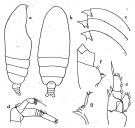 issued from : G.P. Farran in British Antarctic (\"Terra Nova\") Expedition, 1910. Natural History Reports. Zoology. Vol. VIII. Crustacea, 1929. [p.235, Fig.7]. Female (52°11'S, 167°25'E): a, habitus (lateral view); b, idem (dorsal view); c, rostrum (three specimens); d, A2; e, first foot; f, fifth foot (basal joints); g, inner edge spines of first basal joint of fifth foot.
|
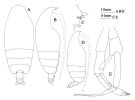 issued from : J.M. Bradford & J.B. Jillett in Mem. N.Z. oceanogr. Inst., 86, 1980. [p.40, Fig.24]. Female: A, habitus (dorsal); B, idem (lateral right side); C, inner edge of basipod 1 of P4. Male: D, habitus (lateral right side); E, P5.
|
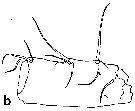 issued from : J.C. von Vaupel Klein in Crustaceana, Supplt 9, Studies on Copepoda, III, 1984. [p.75, Fig.13, b]. Female: b, condition of the single, doubly serrate seta (arrowed) of group I on basipodite 1 of Mxp (right appendage in medial aspect).
|
 issued from : J.C. von Vaupel Klein in Zool. Verh. Leiden, 1998, 323. [p.387, Fig.2]. Measurements taken from maxilliped: Ba1 = length of basipodal segment 1; Ba2 = length of Ba2; S = length of the longest seta of the only ramus (endopodite). measurements used to compare with other species (tables 1 and 2) in view of the speciation (see discussion after Von Vaupel Klein (1998, pp.389-397) in the genus Euchirella.
|
 issued from : J.C. von Vaupel Klein in Zool. Verh. Leiden, 1998, 323. [p.386, Table 2]. Dimensions of adult females of E. rostrata, E. rostromagna, and E. latirostris, presumably relevant in the separation of niches. 1/ See Material and methods (Von Vaupel Klein, 1998, pp.385-385); 2/ Present collections: 2.7-3.85 mm; 3/ Present collections: 5.3-6.2 mm; 4/ Present collections: 5.4-6.2 mm; 5/ Of E. rostrata vs the average of the two larger spp.; 6/ Of E. rostromagna vs E. latirostris; 7/ From Von Vaupel Klein 1984, p.93); 8/ Of E. rostrata vs E. rostromagna and of E. rostrata vs E. latirostris, respectively.
|
 Issued from : J.C. von Vaupel Klein in Crustaceana, (Supplement) 9, 1984. [p.93, Table II]. Euchirella latirostris Female: Datamatrix stating observed states of characters from Table I (p.87-90) presently examined; nos. refer to the input nos. used in Table I (see to the family Aetideidae).
|
 Issued from : J.C. von Vaupel Klein in Crustaceana, (Supplement) 9, 1984. [p.94, Table II (cont' d) ]. Euchirella latirostris Female: Datamatrix stating observed states of characters from Table I (p.87-90) presently examined; nos. refer to the input nos. used in Table I (see to the family Aetideidae).
|
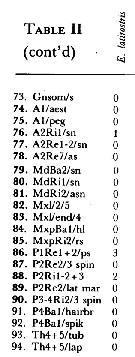 Issued from : J.C. von Vaupel Klein in Crustaceana, (Supplement) 9, 1984. [p.95, Table II (cont' d) ]. Euchirella latirostris Female: Datamatrix stating observed states of characters from Table I (p.87-90) presently examined; nos. refer to the input nos. used in Table I (see to the family Aetideidae).
| | | | | Compl. Ref.: | | | Sewell, 1948 (p.569, 573); Razouls & al., 2000 (p.343, tab. 3, Appendix) | | | | NZ: | 3 | | |
|
Distribution map of Euchirella latirostris by geographical zones
|
| | | | | | 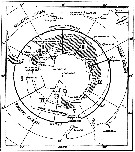 issued from : W. Vervoort in B.A.N.Z. Antarctic Reseach Expedition, Reports - Ser. B, Vol. III, 1957 [Fig.41] issued from : W. Vervoort in B.A.N.Z. Antarctic Reseach Expedition, Reports - Ser. B, Vol. III, 1957 [Fig.41]
Chart showing the geographical distribution (white triangle) in the seas surrounding the Antarctic continent.
Nota: In this chart the area frequented by whaling vessels has been hatched. The Antarctic circle (66°.5 S) has been drawn as a broken line. The numbers I to VI refer to the sectors into which the Antarctic seas are divided according to Mackintosh (1942) (after Vervoort, 1951). |
 issued from : J.C. von Vaupel Klein in Zool. Verh. Leiden, 1998, 323. [p.392, Fig.5]. issued from : J.C. von Vaupel Klein in Zool. Verh. Leiden, 1998, 323. [p.392, Fig.5].
Map showing the distributional areas of E. rostrata (Claus, 1866), E. rostromagna Wolfenden, 1911, and E. latirostris Farran, 1929 , respectively; note the considerable overlap in range of E. rostrata and the other two species which, in their turn, are virtually coinciding in a strictly geographic sense. Antarctic convergence i(AC). |
 Issued from : J.M. Bradford & J.B. Jillett in New Zealand Ocean. Inst. Memoir, 86, 1980. [p.88-89, Figs.65-67]. Issued from : J.M. Bradford & J.B. Jillett in New Zealand Ocean. Inst. Memoir, 86, 1980. [p.88-89, Figs.65-67].
Distribution of several species of Euchirella in the Tasman Sea and around New Zealand.
Nota: Euchirella indica (= Euchirella massinensis indica). |
| | | | Loc: | | | sub-Antarct. (Indian, SW Pacif.), S Atlant., Tasmania, New Zealand, Campbell Is. | | | | N: | 5 | | | | Lg.: | | | (35) F: 5,4; (201) F: 5,8; M: 4,2; (1257) F: 5,4-6,05; {F: 5,40-6,05; M: 4,20} | | | | Rem.: | Meso-bathypelagic.
Sampling depth (sub-Antarct.) : 0-750 m.
For Vervoort (1957, p.64) this species resembles E. rostromagna; it may be distinguished by the shape of rostrum (shorter and very thick at the base); in addition there are small differences in the shape of the teeth on the posterior surface of the basal segment of P4. A1 have densely haired setae.
For Bradford & Jillett (1980, p.39) there is some possibility that E. latirostris and E. rostromagna represent the two extremes of variation in one species. From the few records of this species it appears to live in warmer subantarctic waters.
See Vaupel Klein's remarks (1984 a, p.45-46) in E. rostromagna. | | | Last update : 22/02/2021 | |
|
|
 Any use of this site for a publication will be mentioned with the following reference : Any use of this site for a publication will be mentioned with the following reference :
Razouls C., Desreumaux N., Kouwenberg J. and de Bovée F., 2005-2025. - Biodiversity of Marine Planktonic Copepods (morphology, geographical distribution and biological data). Sorbonne University, CNRS. Available at http://copepodes.obs-banyuls.fr/en [Accessed July 11, 2025] © copyright 2005-2025 Sorbonne University, CNRS
|
|
 |
 |












